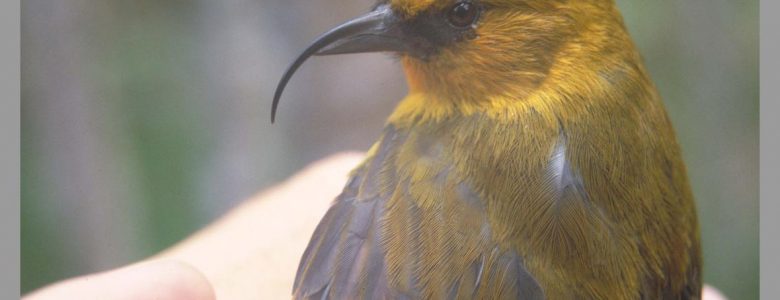August 5, 2019
Forest Birds Find Home in Hakalau Forest National Wildlife Refuge

By: burgundy bug
Endangered Hawaii forest bird, ‘Akiapōlā‘au
Source: Hawaiian Birds Rapidly Colonize Young Restoration Forest | USGS
Photo courtesy of Carter T. Atkinson
Birds native to Hawaii are flocking to one of the largest, ongoing reforestation efforts at the Hakalau Forest National Wildlife Refuge, according to the study recently published in Restoration Ecology.
A Bit of Context…
Koa trees with grass understory at Hakalau Forest National Wildlife Refuge
Source: Hawaiian Birds Rapidly Colonize Young Restoration Forest | USGS
Photo courtesy of Stephanie Yelenik
The Hakalau Forest is a national wildlife refuge on the big island of Hawaii that spans over 32,733 acres, their website reports. The forest serves as home to a variety of wildlife including birds, mammals, and arthropods.
Prior to the establishment of the refuge in 1985, Hakalau Forest had been subject to degradation from over 150 years of cattle grazing at the upper-levels, according to the US Fish and Wildlife Service. The lower levels had been subject to degradation from cattle and pigs.
Since the reforestation program began in 1989, over 400,000 native plant species had been planted in Hakalau Forest. Over 20,000 plants are grown in on-site greenhouses and transplanted into the forest annually by volunteers and horticulturists alike.
The higher elevations of Hakalau Forest on the slopes of Mauna Kea protect birds from diseases spread by mosquitoes, as the temperatures are too cool for the insects to inhabit, the US Geological Survey (USGS) said in a recent press release.
This allows the birds to thrive, free from disease, habitat loss, and invasive predators.
Flocking to Hakalau
“The study results show the birds are responding positively to restoration efforts faster than anyone thought possible. Birds are now in parts of the refuge where they weren’t found 10 to 20 years ago.”
Eben Paxton, USGS researcher
Recently, researchers analyzed bird survey data collected over the last 26 years and found the population of most bird species within the restoration area had increased. Their populations increased most notably in the densest, most diverse areas of Hakalau Forest.
Hawai‘i ‘Elepaio
Source: Hawaiian Birds Rapidly Colonize Young Restoration Forest | USGS
Photo courtesy of Kelly Jaenecke
Within the refuge, birds can enjoy nectar, small fruits, seeds, and other insects as they please. Hakalau Forest provides avian species with a safe, bountiful home and the positive effects show in the increase in birds.
However, as the climate continues to change and temperatures rise, the cooler areas that are free from malaria carried by mosquitoes will shrink. Continuing to protect the higher elevation forests will be crucial to sustaining the now-thriving bird population at Hakalau Forest.
Read: What’s the Deal with Climate Change?
The Burgundy Zine
Currently, the climate of Hakalau Forest is wet with moderate temperatures. At higher elevations, temperatures have reached a maximum of 75 degrees Fahrenheit and a low of 25 degrees Fahrenheit, the Hakalau Forest National Wildlife Refuge Comprehensive Conservation Plan reports.
Hawaii is no exception to the global effects of climate change. Over the last century, the surface of the island has warmed by 4.4 degrees Fahrenheit.
However, the Hakalau Forest National Wildlife Refuge is dedicated to sustaining the environment for the life that inhabits it and will continue restoration efforts to ensure their native birds have a place to call home.
“We have a clearer picture of how we can facilitate expansion of particular bird species into reforestation areas by creating particular plant communities; this will help us ensure that Hakalau Forest National Wildlife Refuge can continue to be a stronghold for Hawaiian forest birds.”
Steve Kendall, U.S. Fish and Wildlife Service Wildlife Biologist
Overlooking koa restoration forest in former pastureland at Hakalau Forest National Wildlife Refuge
Source: Hawaiian Birds Rapidly Colonize Young Restoration Forest | USGS
Photo courtesy of Stephanie Yelenik
Interested in having content featured in an upcoming blog post or issue of The Burgundy Zine? Head on over to the submissions page!
For all other inquiries, please fulfill a contact form.





